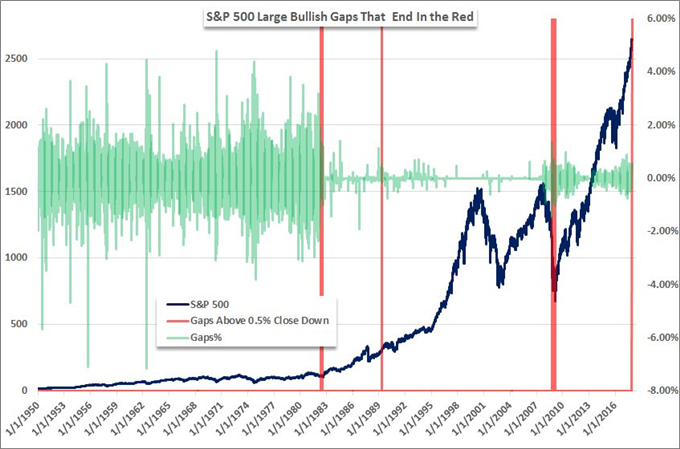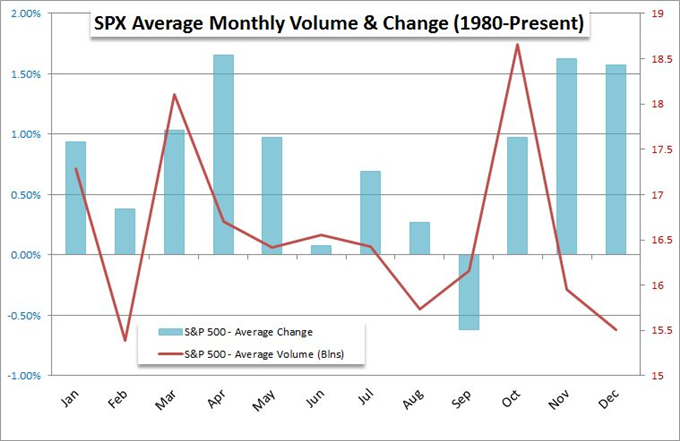In a mirror of Friday's volatility, the S&P 500 started the new week with a bullish gap with an abrupt reversal through the day. Will volatility defy seasonal norms and create a problem for a liquidity drained financial system?
Talking Points:
- The S&P 500 posted its largest bullish gap in 7 months, but a subsequent red close is an exceedingly rare reversal for the market
- Tax headlines were churning the Dollar as well, but the amplitude was far more constrained with key tech levels still in place
- US and UK event risk will likely hold limited influence compared to Tax and Brexit headlines, but the RBA decision can register
What are the top fundamental themes for the coming week? Are there critical technical patterns that you're missing? Do you have market, trading or strategy questions you want answered? See what live webinars we have scheduled on the DailyFX Webinar Calendar.
Volatility without direction can be disruptive. In a market as dependent on complacency as ours has been these past months and years, it could prove disastrous with the wrong development. We are entering the first full week of December and the precedent and expectations are clear: this is both one of the quietest months of the calendar year and in turn one of the best for producing returns in risk assets. This would not be a good year to break from that convention given how extreme the market is in terms of exposure (leverage and asset type) while participation has dwindled down to extreme levels. In low liquidity periods, the addition of volatility can lead to extreme swings in price that can quickly escalate to systemic level. That said, the S&P 500 started off this new trading week with a gap higher - as did many other risk oriented assets - but would ultimately end the day in the red. In fact, the bullish gap was the largest since late April. Looking back at historical price action on the benchmark equity index, a gap of 0.5 percent or more on the open that subsequently closes with a loss is exceptionally rare.
The scale of the jump higher and the abruptness of the reversal in US markets mirrors what we had seen Friday. Late last week, the market plunged with news of political risk in the continuity and functioning of the executive branch that was later reversed when news hit the wires that the Senate had enough votes to progress the tax bill. The direction changed, but the tendency towards volatility remained. In other markets, the sensitivity to global winds was felt via correlations. The FTSE 100, DAX, Nikkei 225 and Chinese indices all registered wobble but were not willing to commit without a cue from US markets. Emerging Markets, Yen crosses (carry trade) and junk assets were all posturing around key technical levels. The importance of watching risk trends across regions and asset types is clearer in these markets, but it can also be difficult to register. In this case, volatility measures are great initial warning signs that we should perhaps investigate more closely. The VIX and short-term VXST alone show a consolidation with a floor at record lows that will inevitably have to resolve itself.
In the FX world, the Dollar seemed to be responding to the same tax news that initially flushed equities. The Dollar jumped on the open but showed it held little intention to make a trend of the jump. This leaves many of the Dollar-based majors in technically vulnerable positions. Among the pairs, GBP/USD is on the bullish side of a multi-year trendline break, USD/CAD stands at the floor of a wide range after Friday's collapse, USD/CHF has hit the upper bounds of a descending trend channel and NZD/USD is forming the right shoulder on an inverse head-and-shoulders pattern. These are all noteworthy patterns, but what can feasibly offer the impetus to 'trigger' their potential? Meanwhile, the Pound holds its fundamental on its sleeve. The Brexit headlines provided breaks to the Cable, GBP/JPY, GBP/AUD and others. Yet, news of an Irish veto over the Brexit plan on the EU side has undercut confidence in a recovery rally just as quickly as it arrived. These big-picture themes with little definitive timeline around them will remain capable - if unruly - drivers. For most other currencies and assets, scheduled data will be significantly less capable; perhaps with the notable exception of the RBA rate decision. The Aussie central bank only has to say 'hike' in the context of a clear time frame in 2018 and the AUD could capitalize on a deep discount. We discuss all of this and more in today's Trading Video.
To receive John’s analysis directly via email, please SIGN UP HERE.







